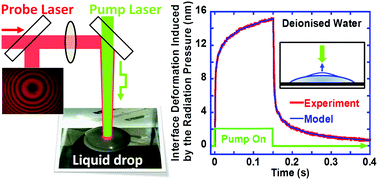Contactless thin-film rheology unveiled by laser-induced nanoscale interface dynamics
Abstract
One of the classical limitations for the investigation of the local rheology of small scale soft objects and/or confined fluids is related to the difficulty to control mechanical contact and its consequences. In order to overcome these issues, we implement a new local, active, fast and contactless optical strategy, called optorheology, which is based on both the optical radiation pressure of a laser wave to dynamically deform a fluid interface and interferometry to probe this deformation with nanometric resolution. This optical approach is first validated by measuring the surface tension and the viscosity of transparent Newtonian liquids. We also show how non-equilibrium situations, such as continuous evaporation, can be used to deduce the thickness dependence of the rheology of thin films and the concentration dependence of the viscosity of binary liquid mixtures and suspensions. We further extend the investigation to elasticity and viscoelasticity measurements of polymer solutions. Finally, since liquids may absorb light, we discuss the influence of a weak laser heating and the triggering of interface deformations by thermocapillary tangential stresses that could represent a complementary approach to probe the rheology at small scale.



 Please wait while we load your content...
Please wait while we load your content...